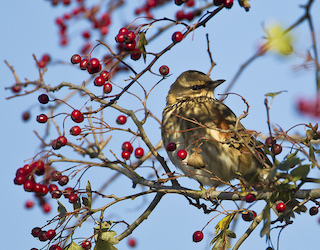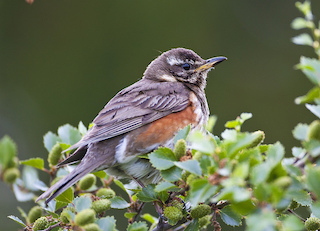 Windmill Farm is a good place to spot these winter visitors.
Windmill Farm is a good place to spot these winter visitors.
Photo: © Natural England/Allan Drewitt
Scientific name: Turdus iliacus
Other common names: Red-winged Thrush
Cornish name: Winnard
Conservation status: IUCN Red List, Near Threatened; UK Birds of Conservation Concern, Red
What to look for:
• Colouring and appearance: Small thrush, with very distinctive red-brown underwings and flanks. The cream-coloured stripe above the eye is also distinctive. Its upperparts are grey-brown, and the underparts are buff, streaked black. Pinkish legs and dark beak. Both sexes are similar in appearance to each other.
• Size: Wingspan 34 cm, length 21 cm.
• Where: Breeds across northern Eurasia in forests and tundra; a winter visitor to the UK, often found in flocks in grassy fields, orchards and hedgerows.
• Call: Listen here
• Similar species: Mistle Thrush, Fieldfare.
 On late autumn evenings, you might just be fortunate enough to hear Redwings as they migrate through the skies. This small thrush species migrates by night and, while you are more likely to hear them in the east of the UK, it is always worth listening out for their twittering calls overhead. Some 650,000 individuals visit Britain in the winter, often forming mixed feeding flocks with Fieldfares. Their main diet consists of invertebrates, earthworms and, especially during the autumn and winter, seeds and berries. Not a common garden visitor, in harsher winter conditions they might be attracted by cotoneaster and other garden plant berries.
On late autumn evenings, you might just be fortunate enough to hear Redwings as they migrate through the skies. This small thrush species migrates by night and, while you are more likely to hear them in the east of the UK, it is always worth listening out for their twittering calls overhead. Some 650,000 individuals visit Britain in the winter, often forming mixed feeding flocks with Fieldfares. Their main diet consists of invertebrates, earthworms and, especially during the autumn and winter, seeds and berries. Not a common garden visitor, in harsher winter conditions they might be attracted by cotoneaster and other garden plant berries.

The Redwing’s breeding grounds lie further to the north, including Iceland, the Faroes, Siberia and other parts of northern Europe. The breeding season is from April to July. They make their cup-shaped nests of grasses, mosses and twigs, holding them together with mud and lining them with leaves and grass. The clutch of four to six eggs hatch within two weeks, and the youngsters fledge around two weeks later. The adults have fairly cosmopolitan tastes in where they build their nests – anything from conifer or birch forest edges and clearings, tundra vegetation to parks and rocks.
Recent declines in both the breeding and winter populations mean Redwings are considered under threat across their range, and are now ranked Near Threatened on the IUCN Red List.
Did you know…?
…A very small number of Redwings (around ten pairs) breed in Scotland.
More information and references:
Svensson, L., Mullarney, K., Zetterstrom, D.,1986. Collins Bird Guide, second edition (translated by Christie, D., Svensson, L.). HarperCollins, London.
Published: February 2016
Author: Amanda Scott
Photos: © Natural England/Allan Drewitt
